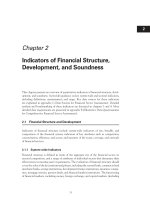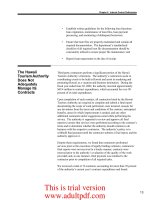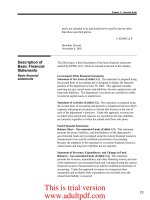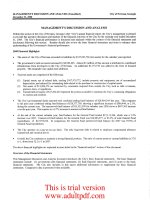Chapter 2: Lack of Planning and Fractured Management Undermine the State’s Tax Collection Efforts_part3 pdf
Bạn đang xem bản rút gọn của tài liệu. Xem và tải ngay bản đầy đủ của tài liệu tại đây (445.02 KB, 11 trang )
27
Chapter 2: Lack of Planning and Fractured Management Undermine the State’s Tax Collection Efforts
by CGI and delivered to DoTAX in the form of (1) written documents,
including reports, system documentation, system design, and blue prints;
(2) software, including developed software and third-party software;
and (3) hardware, including personal computers, routers, and mini
processors. The 22 initiatives were divided into two phases. Phase 1
initiatives were to be implemented within the rst 24 months after the
effective date of the contract. Phase 2 initiatives were to commence if
the collections from Phase 1 initiatives were sufcient to compensate
CGI with $9.8 million.
The 2009 contract modication removed the obligation of the vendor
to complete the 2008 contract’s 22 initiatives. Instead, the modication
included a list of 21 revenue generating initiatives from which DoTAX
could choose, but did not dene deliverables or include a time table
for delivery. The 2009 modication provided for ten CGI consultants
to perform services “as directed by DoTAX.” Of the 21 initiatives,
DoTAX chose ve for CGI to complete. Appendix A compares what was
originally contracted for in the 2008 contract with what will actually be
delivered by the 2009 modication.
According to best practices, National State Auditors Association,
Contracting for Services, contract provisions should include tying
payments to the acceptance of deliverables or the nal product. Because
the 2009 modication does not tie payments to deliverables and, in fact,
does not dene deliverables, the department received less value and
accountability than in the 2008 contract.
The modication offered a “buffet list” of initiatives from which the
department could choose. The former deputy director picked the list
herself without consulting department managers, the Department of the
Attorney General, or the Governor’s Ofce. The governor’s chief of
staff, however, was aware that the department intended to modify the
contract to offer a cafeteria-style buffet list of options. The vendor’s
project manager commented that the 2009 modication terms are unusual
in that compensation is usually tied to a deliverable.
Although the 2009 modication may have provided the department with
more exibility to prioritize and select only those initiatives that would
best t the department’s needs and capabilities, the overall cost of the
contract—$25 million—did not change. As shown in Appendix A, the
department paid $25 million for far less than it had originally bargained.
In addition, without contractual language tying the vendor to complete its
work, the 2009 modication placed the department in a tenuous position
should another dispute arise and the vendor once again threatens to walk
away from the contract. The absence of contractual language dening
the vendor’s obligations further weakens the department’s position.
Finally, if the 2009 modication allowed the department to pare down
This is trial version
www.adultpdf.com
28
Chapter 2: Lack of Planning and Fractured Management Undermine the State’s Tax Collection Efforts
the initiatives to align with what it could have supported, we question
the department’s judgment in 2008 when it embarked on what appears to
have been an overambitious $25 million project.
Second, the 2009 modication removed a contractual constraint
limiting payment to CGI to $9.8 million for work associated with the
2008 contract, Phase 1. The 2009 modication effectively allowed
CGI to receive the remaining compensation of $15.2 million from new
collections without rst completing deliverables from the 2008 contract,
Phase 1. According to the 2008 contract, CGI would perform the
Phase 1 Collections Initiatives, which consisted of eight initiatives, and
the department would pay CGI one-third of the department’s collections
arising from that work until such time as CGI has been paid $9.8 million
in fees. Upon reaching the compensation threshold of $9.8 million,
the department had “no further obligation to compensate CGI for the
Phase 1 Collections Initiatives.” CGI would then be obligated to begin
each of the 2008 contract Phase 2 initiatives on a one-by-one basis as
the cumulative compensation thresholds to CGI were achieved. Phase 2
consisted of 14 initiatives.
Third, the 2009 modication deleted contract provisions relating to
the acceptance of software deliverables and warranties. This deletion
removed the department’s ability to require the testing, approval, and
remediation of faulty deliverables, in addition to the ability to hold the
vendor accountable for defects and system integration problems during
the warranty period. In other words, if problems arose with work
completed by CGI, the department could not hold CGI accountable to x
the problems. The 2008 contract included several sections that dened
the acceptance procedures for both written and software deliverables and
included test procedures and remediation requirements if defects were
found. The 2009 modication, however, deletes these sections by stating
that they “shall not apply.”
Warranties are typically included in state contracts. Without such
warranties the department has no contractual ability to hold the vendor
accountable for potential defects and system integration problems.
Thus, when CGI completes its work and leaves on June 30, 2011, the
department has no recourse should problems arise.
The department’s advising deputy attorney general did not have
concerns with the 2009 modication being written without deliverable
dates, testing requirements, or warranty stipulations. He stated that
the contract speaks for itself and that as the lawyer for the department
he knows that there has never been a warranty issue that needed to be
addressed. The governor’s chief of staff acknowledged that this was
This is trial version
www.adultpdf.com
29
Chapter 2: Lack of Planning and Fractured Management Undermine the State’s Tax Collection Efforts
not a traditional contract. The deputy attorney general said that the
vendor does not get paid unless it generates new collections. Once the
collections are realized, the contract is satised.
Both of these answers are shortsighted. Whether warranty issues have
been raised in the past is irrelevant to future potential problems that
could occur as modications are made to the computer system. In
addition, even though the intent of the 2009 modication was to bring
in revenue, the vendor was required to make changes to the computer
system in order to fulll the contract. The fulllment of the revenue
generation requirement of the contract should not absolve the vendor
from responsibility for changes it made to the department’s computer
system.
Finally, the 2009 modication does not hold CGI accountable to
complete the initiatives set forth by the department. The modication
provides that CGI’s obligations to provide all services under the 2009
modication shall be deemed complete by June 30, 2011, thereby
relieving CGI of any obligation to complete on-going initiatives. The
director believes that CGI will complete the work because “their
reputation is more than nishing the job.” The director also said that
CGI is a large company and if it were to stop work, Hawai‘i would have
“a negative outlook” on it.
CGI’s project manager stated that the State has already paid CGI the
maximum $25 million for the current contract. Further, he stated that
the State could ensure that the work will be completed because the
contract was based on a sound partnership. CGI was paid to maximize
tax revenue, and all decisions have been made on that basis.
The DoTAX has relied on performance- and benets-based contracts to
fund its IT system enhancements. The department paid for both its 1999
ITIM system contract and 2008 Delinquent Tax Collections contract
from the tax revenues collected by these automated tax systems. The
1999 contract’s funding and procurement was very transparent—the
Legislature appropriated funds for the development of the IT system
and the competitive sealed proposal procurement method was used.
In comparison, the 2008 contract was less transparent—the contract
was funded by a trust account that does not go through the legislative
appropriations process and the sole source procurement method was
used. Finally, the department will have to grapple with how to fund its
ITIM system’s ongoing demands after June 30, 2011, when the funding
from additional tax revenue will cease.
The DoTAX’s funding
mechanism for its ITIM
system will end
This is trial version
www.adultpdf.com
30
Chapter 2: Lack of Planning and Fractured Management Undermine the State’s Tax Collection Efforts
The 1999 ITIM system contract’s performance-based funding
was transparent
The initial acquisition of the ITIM system was very transparent. The
Legislature appropriated funds for the redesign and acquisition of the
system, and the development work was procured using the competitive
sealed proposal-request for proposal (RFP) procurement method. A
special fund was established to meet the obligations of the contract, and
the department was required to provide progress reports on the project to
the Legislature.
Act 273 (SLH 1996) authorized the department to enter into
performance-based contracts for the redesign and acquisition of the new
ITIM system. The director was required to report to the Legislature
the status of the contract and provide an accounting of all moneys
appropriated and detailed information on the cost and benets of
implementing the automated tax systems, the amount of increased tax,
interest, and penalties collected, and the amount paid to the vendor.
Act 155 (SLH 1999) established the Integrated Tax Information
Management Systems Special Fund in the state treasury that consists of
general excise tax revenues. The fund moneys were intended to be used
by the department to pay for the system contracts. The department was
also required to submit an annual report to the Legislature providing an
accounting of the receipts and expenditures from the fund, which it did
for 2002, and 2005 through 2007. The special fund was repealed on
July 1, 2005.
The contract was procured using the competitive sealed proposals-RFP
procurement method, and the contract term was not to exceed ten years.
The comptroller, in consultation with the director of nance, reviewed
and approved the nancing arrangement. As required by the RFP
process, public notices were posted soliciting proposals for a business
partner to provide an integrated tax information management system;
proposals were evaluated by the department; and an award was made to
CGI’s predecessor, AMS.
The 2008 contract benets-based funding was less transparent
Unlike the 1999 ITIM system contract, the 2008 Delinquent Tax
Collections contract was funded by a trust account that does not go
through the legislative appropriations process. The department attempted
twice to establish an Integrated Tax Services and Management Special
Fund for the 2008 contract. The department then resorted to creating
a trust account from what has been characterized by some department
personnel as a “loophole” in the statutes. The trust account would
reect the moneys collected from the delinquent tax collection project
identied accounts as well as the payments made to CGI for the contract,
This is trial version
www.adultpdf.com
31
Chapter 2: Lack of Planning and Fractured Management Undermine the State’s Tax Collection Efforts
all without legislative appropriations and approvals and without utilizing
the department’s budget. We conrmed that both the 2010 Senate Ways
and Means and House Finance Committee chairs were not aware of this
payment arrangement. In addition, the department used the sole source
procurement method, which does not involve competition. According
to the department, the 2008 contract was procured using this method
because of the proprietary nature of the ITIM system. Overall, both the
2008 contract’s payment process and procurement method were less
transparent than the prior contract.
In July 2007, the department sought legal advice from the Department of
the Attorney General regarding authority to contract without legislative
appropriation. The department advanced Section 231-13, HRS, as
a possible legal authority for the intended contract. Section 231-13,
HRS, provides that the director of taxation shall be responsible for
collection of all delinquent taxes and may select and retain bonded
collection agencies, licensed attorneys, accountants, and auditors or
other persons for the purpose of assessment, enforcement, or collection
of taxes. According to the law, all compensation can be paid out of the
taxes recovered for the State or from the debtor according to the amount
authorized by the contract.
The Department of the Attorney General responded that a strong
argument can be made that Section 231-13, HRS, permits the contract
because the vendor would qualify under the broad other person language
of the statute. The response concluded that “a court would construe
section 231-13, Hawai‘i Revised Statutes to allow the department to
contract CGI for the assessment, collection or enforcement of taxes.”
(emphasis added).
In December 2007, the department requested the governor’s approval to
enter into a contract with a vendor to assist the department in collecting
additional delinquent taxes, stating that there is no cost to the State or
the department, and the vendor will be paid a percentage of the new
delinquent taxes collected. In truth, however, payments to CGI would be
made from the State’s general fund revenues. The governor approved the
department’s request in January 2008.
The Department of Budget and Finance’s advising deputy attorney
general advised the taxation department that it could establish a
trust account as a means to pay CGI since there were no legislative
appropriations. The Department of Accounting and General Services
(DAGS) denes a trust account as a separate holding or clearing account
for state agencies and is often used as an accounting device to credit or
charge agencies or projects for payroll or other costs. In January 2008,
the department requested that DAGS establish a Trust and Agency
This is trial version
www.adultpdf.com
32
Chapter 2: Lack of Planning and Fractured Management Undermine the State’s Tax Collection Efforts
Fund account to deposit new delinquent tax collections. In February
2008, DAGS notied the department that the trust account had been
established. Moneys collected under the contract would be deposited to
the trust account as described in Appendix B.
The contract was procured using the sole source procurement method,
which does not involve competition. As required by this method, the
department submitted a written request to the State Procurement Ofce
chief procurement ofcer for review and approval, stating that “the
enhancements will have to be coordinated and integrated with the current
applications that were developed by CGI to its proprietary software. For
that reason, another vendor cannot perform this work in the proprietary
software.” The chief procurement ofcer posted the notice of sole
source award on the State’s website and in July 2007, SPO approved the
department’s sole source request.
Vendor’s role as a collection agency is unclear
The Department of the Attorney General advised the department that
CGI would qualify as an eligible contractor under the broad other
persons language of Section 231-13, HRS, and the Department of Budget
and Finance advised the department to establish a trust account to handle
revenues and payments. Even so, it is unclear whether the vendor’s
activities t those of a collection agency and if the 2008 contract’s
initiatives are used to assess, enforce, and collect taxes.
Section 231-13, HRS, provides that “the director, by contract, may select
and retain bonded collection agencies, licensed attorneys, accountants,
and auditors or other persons for the purpose of assessment, enforcement,
or collection of taxes….” [emphasis added]. In addition, “all
compensation shall be payable out of the taxes recovered for the State or
from the debtor in accordance with the terms of, and up to the amount
authorized by the contract.” [emphasis added] The former director
questioned whether the 2008 contract ts under this provision of law
because CGI is not actually conducting collection agency activities.
The 2008 Delinquent Tax Collection contract included the General
Excise Tax Non-ler program. For this program and utilizing the ITIM
system, CGI identied general excise tax license holders who had failed
to le tax returns and printed and mailed form letters informing them of
their non-ler status. The letter provided both general excise tax ling
and cancellation procedures. Almost 70,000 letters were sent, generating
thousands of inquiries from taxpayers who called, emailed, mailed, and
visited the department in response to the letters. Inquiries were handled
by the department’s Tax Services and Processing Division, Taxpayer
Services Branch, while the division’s Document Processing Branch
This is trial version
www.adultpdf.com
33
Chapter 2: Lack of Planning and Fractured Management Undermine the State’s Tax Collection Efforts
expedited the processing of more than 19,000 previously unled returns
and almost 13,000 license cancellations submitted by the letter recipients.
As of June 2010, over 300,000 letters have been sent.
The former director explained that the vendor’s activities, which were
limited to identifying the non-lers, printing the letters, and paying for
postage, differ from those of a collection agency that actually collects
moneys. Beyond the vendor’s activities, the department did everything
else, including elding inquiries and processing returns and license
cancellations.
We reviewed the 2008 contract and noted that the majority of its 22
initiatives—as shown in Exhibit 2.2—do not involve the assessment,
enforcement, or collection of taxes as required by Section 231-13,
HRS. For example, Initiative No. 2, Integration of Miscellaneous Tax
Types and Automated Compliance Check, involves the integration and
automation of seven manual tax types (fuel, franchise, estate and transfer,
liquor, tobacco, public service company, and timeshare occupancy
tax) into the ITIM system. Similarly, Initiative No. 11, Customer
Relationship Management Implementation, involves the implementation
of a software tool and a strategy for interacting with customers. The
new tool allows the department to better manage its workload by
consolidating all interactions with the taxpayer. And Initiative No. 13,
ITIMS Server/Disk/Workstation Capacity, which involves increasing
server, workstation, and disk storage capacity, accommodates processing
volume growth rates over a ve-year period. Thus, even if needed, these
initiatives do not appear related to assessment, enforcement, or collection
of taxes as required by law.
This is trial version
www.adultpdf.com
34
Chapter 2: Lack of Planning and Fractured Management Undermine the State’s Tax Collection Efforts
Moreover, the bulk of the revenues generated by CGI came from the rst
initiative—the registered business non-ler enhancements—which cost
an estimated $580,000 out of the $25 million paid, or about 2 percent of
the total contract cost. The moneys generated by the non-ler program
were used to pay for other initiatives. If the goal was to generate
revenue, the department would have accomplished this by contracting
only for the non-ler program, with a savings to the State of about $24.4
million. The additional revenue generated from this program would have
been deposited to the State’s general fund.
Exhibit 2.2
2008 Contract Initiatives
# Initiatives Phase Cost
1 Registered Business Non-Filer Enhancements 1 $580,000
2 Integration of Miscellaneous Tax Types and Automated Compliance Check 1 $2,110,000
3 Automated Address Updates 2 $304,000
4 Self Service Payment Agreements Through IVR 1 $268,000
5 Support Fed-State Compare for Ofce Audit 1 $1,550,000
6 Audit Case Management Enhancements 2 $1,520,000
7 Additional Reports to Support Audit 2 $250,000
8 Risk Modeling 2 $1,473,000
9 Enhanced Audit Data Warehouse 1 $1,328,000
10 Electronic Data Sources Audit Data Warehouse 2 $320,000
11 Customer Relationship Management Implementation 2 $3,298,000
12 Virtual Call Center & Automated Phone Calls for Collections 2 $895,000
13 ITIMS Server/Disk/Workstation Capacity 2 $1,300,000
14 System Software Upgrades 2 $911,000
15 Personal Inc Tax Fraudulent Refund Detection 2 $580,000
16 Audit Review of Corp Inc Tax Refund and Amended Returns 1 $320,000
17 Collections Business Process Improvements 2 $250,000
18 Tax Processing Business Proc Improvements 2 $810,000
19 Additional Delinquent Tax Support (Part 1) 1 $2,125,000
20 Additional Delinquent Tax Support (Part 2) 2 $2,125,000
21 Design Changes (Part 1) 1 $1,070,000
22 Design Changes (Part 2) 2 $1,070,000
Contingency for Interest $500,000
TOTAL COST: $24,957,000
Source: Department of Taxation
This is trial version
www.adultpdf.com
35
Chapter 2: Lack of Planning and Fractured Management Undermine the State’s Tax Collection Efforts
The 1999 ITIM system project was to have ended in 2004, but is still
on-going and straining the department’s limited IT stafng resources
with continuous projects, tax law changes, enhancements, and xes.
As a result, the department has become dependent on its IT vendor to
supplement on-going IT work as well as resolve long-standing system
problems.
The department has failed to establish and implement an IT strategic
plan to address its processes, organization, technology, and people. The
department now faces the impending June 30, 2011 departure of its IT
vendor without an IT strategic plan that lays out how it will support
the maintenance and enhancement of its ITIM system with its existing
stafng and budget.
Since the advent of the 1999 ITIM system project, the DoTAX has
moved from one project to the next, implementing new initiatives to
modify and upgrade the system. In addition to these initiatives, the
department’s IT and System Administration Ofce staff have had to
contend with ongoing tax law changes, as well as system enhancements
and xes. During this period of initiatives and enhancements, the
department failed to acknowledge that it was taxing its personnel beyond
their capabilities. We found that the internal IT staff are frustrated by too
much work and not enough time. System administrators are spending
the majority of their time doing system testing at the expense of other
responsibilities. As a result, long-standing system problems have
remained unresolved for years. In addition, staff shortages required the
vendor to assist with these otherwise unmet needs.
DoTAX has been in near continuous project development mode
for more than a decade
In 1999, the DoTAX commenced a ve-year, $51 million ITIM system
project to replace its aging computer systems. By October 2004, the
project completed six major system implementations including the
replacement of the Comprehensive Net Income Tax (CNIT) computer
system in 2002 and the General Excise Withholding/Transient
Accommodations (GEW/TA) system in 2004.
Between January 2005 and January 2008, 13 additional projects
and enhancements were added to the system. At the same time, the
department also contracted in September 2006 with the same IT vendor
to implement the County Surcharge Taxes project. The purpose of this
$2.44 million project was to enhance the ITIM system to allow the
system to process and distribute county surcharge taxes. This additional
The Department’s
Infrastructure
Cannot Sustain
the Current
Rate of System
Enhancements
DoTAX IT staff cannot
keep up with the
department’s ongoing
system demands
This is trial version
www.adultpdf.com
36
Chapter 2: Lack of Planning and Fractured Management Undermine the State’s Tax Collection Efforts
tax of 0.5 percent on the State’s general excise tax is imposed by the City
and County of Honolulu, but levied, collected, distributed, and otherwise
administered by the State.
Then, in January 2008, the department put into effect the $25 million
ITIM system post implementation Delinquent Tax Collections Initiatives,
which called for 22 collection initiatives to be completed by June 2011.
This contract was later superseded by a modication in June 2009, which
reduced the number of initiatives to 21.
In addition, tax law changes (TLCs) were continuously being
implemented. Using the DoTAX annual reports, we calculated an
average of 18 TLCs per year since 2005, including the 2006 county
surcharge. However, not all TLCs result in ITIM system changes. For
example, for the period January 2009 through January 2011, six of a total
of 14 TLCs impacted either IT staff development or TLC team testing.
Throughout this period, bug xes and system enhancements were
being developed, tested, and put into builds to resolve issues and
implement new system enhancements. A bug is a problem with how
the system is working while an enhancement is a change to the system
that adds capabilities or makes the system more efcient. Incidents are
occurrences of problems, and when grouped together, are called builds.
To address system problems, a department build coordinator works with
the system administrators and IT staff to prioritize all incidents that are
identied each week. Due to a shortage of personnel, department staff
said that only critical incidents can be addressed. Non-critical issues are
set aside and worked on only as time permits.
Based on this prioritization process, the build coordinator creates a build
list consisting of several incidents that are grouped together into a build.
We found that between August 2005 and June 2010, a total of 103 builds
have been completed, which amounts to approximately 1.8 builds per
month or one new build being implemented every 17 days. Since each
build includes multiple incidents, we obtained from the department a
breakdown of the number of incidents in each build from 2005 through
2010. We selected and reviewed the builds for 2009 and found that for
that year’s 16 builds, there were 174 production and TLC incidents, or
just over 10.8 incidents per build.
Each incident included within a build goes through an extensive change
management process, which includes the following steps:
Department system administrators discuss and prioritize the •
incident;
One committee reviews and approves the development; •
This is trial version
www.adultpdf.com
37
Chapter 2: Lack of Planning and Fractured Management Undermine the State’s Tax Collection Efforts
The build coordinator organizes the incidents into builds, which •
must be approved by another committee;
Developers develop a solution and test; and •
System administrators test again before the build is nally put •
into production.
This process is repeated from the development stage if any aws in
the solution are discovered during testing. Each hour of development
time requires two hours of testing. Department staff believe there are
too many incidents and not enough system administrators to complete
testing. Currently, system administrators are spending about 75 percent
of their time testing, which is signicantly higher than the 40 percent
allocated in their position descriptions.
A former IT project manager stated that the department was always in
project development mode, which kept the internal IT staff too busy and
did not allow time for the system to stabilize. Still others raised concerns
about the stability of the ITIM system, the ten years of new projects, and
the insufcient internal staff to handle the work. Staff predicted that
there will come a “day of reckoning” when the current contracts end and
the department must pay for the additional costs of the ITIM system with
existing budgets and support the infrastructure with its limited staff.
Staff assessment cites personnel shortfalls
In December 2003, a third-party technology and business solutions
provider was requested by the department to provide an independent
assessment of stafng needs for the ITS Ofce. The study’s goal
was to provide ITS Ofce stafng requirements for a two-year period
ending 2005 and a ve-year period ending 2008. The report found
that “current [ITS Ofce] stafng is not adequate to meet all of the
ofce’s responsibilities.” According to the study, ITS Ofce stafng
levels fell short of the vendor’s estimates, resulting in staff being spread
thin. The study cited an early version of the vendor’s revised stafng
estimate that identied the need for 25 ITS Ofce positions. At that
time, the ITS Ofce had only 21 technical positions, a number which,
according to the study, was not based on actual resource needs, but was
a result of budgetary constraints and prior executive mandate. In light
of this stafng shortage, the study noted that the department’s operating
practice was to “make do” with available resources, which resulted in
staff feeling strained and underappreciated. In order to address the latest
need, the department shifted priorities and deferred important tasks. The
study concluded that when the ITIM system project was scheduled to
be completed in 2004, there would be a corresponding increase in the
demand for application maintenance service.
This is trial version
www.adultpdf.com









